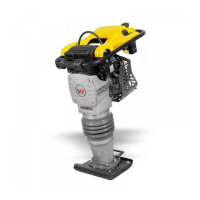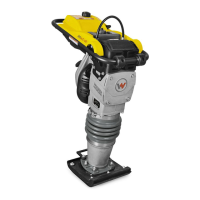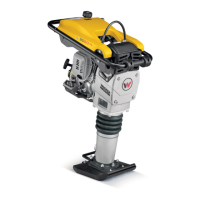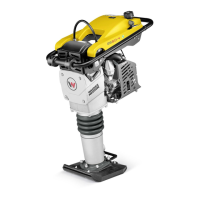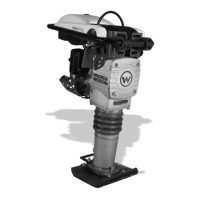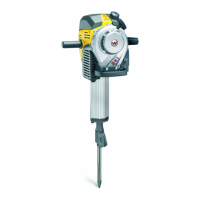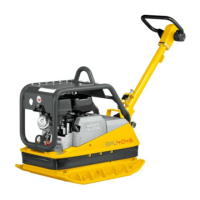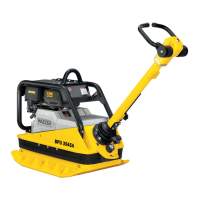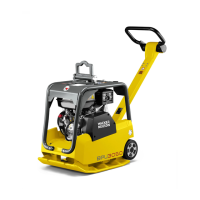What to do if spark plugs are fouled in Wacker Neuson BS 600?
- GGloria GarciaAug 16, 2025
If the spark plugs in your Wacker Neuson Power Tool are fouled, you should clean or replace the spark plug and measure the electrode gap.
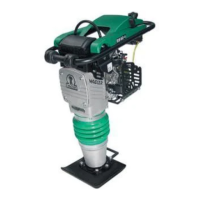
What to do if spark plugs are fouled in Wacker Neuson BS 600?
If the spark plugs in your Wacker Neuson Power Tool are fouled, you should clean or replace the spark plug and measure the electrode gap.
What to do if there is too much oil in the fuel of Wacker Neuson BS 600 Power Tool?
If your Wacker Neuson Power Tool has too much oil in the fuel, drain the fuel tank and refill it with a new, correctly mixed fuel.
Why Wacker Neuson Vibratory rammer & tamper engine hard to start?
If your Wacker Neuson vibratory rammer & tamper engine is hard to start, several factors could be the cause. It could be due to dirty air filters, which require cleaning or replacement. Another cause might be too much oil in the fuel, necessitating draining the old fuel and replacing it with a fresh mixture. Fouled or incorrect spark plugs, a dirty muffler or exhaust port, an incorrect fuel mixture adjustment, or low engine compression can also prevent the engine from starting easily. In the case of leaking crankshaft seals or low engine compression, consult the WM 80 Engine Repair Manual or the WM 80, WM 90 or Yanmar Engine Repair Manual respectively.
What to do if Wacker Neuson Vibratory rammer & tamper engine does not start?
If your Wacker Neuson vibratory rammer & tamper engine won't start, begin by checking if there's fuel in the tank and ensuring the fuel valve is open. A fouled spark plug could also be the culprit; try cleaning or replacing it and setting the electrode gap. Other potential issues include a plugged fuel filter (replace it and inspect the fuel lines), an incorrect fuel mixture adjustment (adjust the screw and clean the fuel jets), a failed ignition module (replace it), or, on machines with oil injection, a failed float switch (replace it).
Why Wacker Neuson Vibratory rammer & tamper engine does not accelerate?
If your Wacker Neuson vibratory rammer & tamper engine isn't accelerating properly or is running poorly, consider these potential causes: dirty air filters (clean or replace them), too much oil in the fuel (drain the tank and refill with new mixed fuel), a fouled or incorrect spark plug (clean, replace, and ensure it's a resistor-type), a dirty muffler or exhaust port (clean them), an incorrect fuel mixture adjustment (adjust the screw and clean the fuel jets), or an air leak in the carburetor system (check all connections). For leaking crankshaft seals, consult the WM 80, WM 90, or Yanmar Engine Repair Manual.
Why Wacker Neuson Vibratory rammer & tamper overheats?
If your Wacker Neuson vibratory rammer & tamper engine is overheating, it could be due to not enough oil in the fuel mix, which requires draining the tank and refilling it with new mixed fuel. Alternatively, the carburetor fuel mix may be set too lean, requiring a reset of the carburetor adjustments. Another potential cause is cooling fins or fan blades packed with dirt, which means you'll need to clean the debris from the fins and blades.
Why Wacker Neuson Vibratory rammer & tamper jumps erratically?
If your Wacker Neuson vibratory rammer is jumping erratically, it could be due to oil or grease on the clutch, which requires inspection and cleaning. Another cause might be broken or worn springs in the ramming system, damaged parts in the spring cylinder assembly, or damaged parts in the crankcase assembly; all these issues require disassembling the relevant components, inspecting them, and replacing any damaged parts. Additionally, soil buildup on the ramming shoe or an engine speed that is too low can also cause erratic jumping. Clean the shoe and adjust the engine speed to resolve these issues.
What to do if the air filters are dirty on Wacker Neuson Power Tools?
If the air filters on your Wacker Neuson Power Tools are dirty, you should clean or replace them.
What to do if the spark plugs are fouled in Wacker Neuson Power Tools?
If the spark plugs are fouled in your Wacker Neuson Power Tools, you should clean or replace the spark plug and measure the electrode gap.
What to do if there is too much oil in the fuel of Wacker Neuson Power Tools?
If there's too much oil in the fuel of your Wacker Neuson Power Tools, drain the fuel tank and refill it with new mixed fuel.
| Brand | Wacker Neuson |
|---|---|
| Model | BS 600 |
| Category | Power Tool |
| Language | English |
Explains sources of engine emissions like CO, NOx, hydrocarbons.
Discusses regulations requiring emission control information.
Details acts that constitute tampering with emission control systems.
Lists symptoms indicating potential engine emission problems.
Recommends genuine parts for emission control system effectiveness.
Advises following the maintenance schedule for emission control.
Explains oxygenated fuels and their use with engine emissions.
Details use of methanol in gasoline and potential issues.
Outlines the warranty coverage for the emission control system.
Specifies warranty duration and coverage for emission-related parts.
Defines owner's responsibilities for maintaining warranty coverage.
Details warranty period, transferability, and repair process.
Explains the procedure for obtaining warranty service.
Lists items and conditions not covered by the warranty.
Limits Wacker's liability for damages and implied warranties.
Lists emission control systems and parts covered by the warranty.
Explains the safety alert symbol and DANGER, WARNING, CAUTION meanings.
Provides crucial safety precautions for operating the rammer.
Details specific safety measures for operating engines.
Outlines safety procedures for maintenance and repair.
Illustrates the location of various safety and information labels on the machine.
Describes the meaning of international pictorial safety labels used on the machine.
Explains the importance of the nameplate and patent status.
Describes the meaning of pictorial operating labels for controls.
Lists engine speed, spark plug, compression, and lubrication details.
Details sound pressure and power levels according to directives.
Provides hand/arm vibration level data as per regulations.
Shows overall dimensions of the rammer with diagrams.
Describes the intended uses for compacting soil and gravel.
Specifies the correct gasoline and oil ratio for the two-cycle engine.
Lists essential steps to take before starting the rammer.
Step-by-step guide on how to start the rammer engine.
Instructions on how to properly shut down the rammer engine.
Advises on keeping the rammer clean, dry, and avoiding no-load strokes.
Details how to achieve best compaction and avoid shoe wear.
A table outlining maintenance tasks and their frequency.
Procedures for cleaning and replacing the dual-element air cleaner.
Details on changing ramming system oil and checking sightglass.
Instructions for checking and tightening shoe hardware with torque specs.
Guidance on adjusting carburetor idle speed and rpm.
Steps for preparing the rammer for long-term storage.
Safety and practical advice for transporting the machine.

